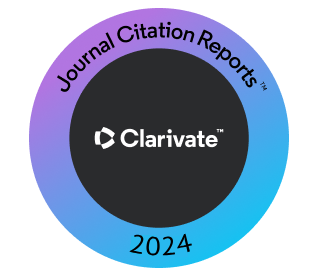Geochemical Insights into the Paleodepositional Environment of the Garagu Formation, Gara Anticline, Kurdistan, Northern Iraq
Abstract
The Garagu Formation is mostly composed of carbonate layers with iron-rich horizons in the middle part. The geochemical evidence for the paleodepositional environment of the Garagu Formation in the Kurdistan Region of Iraq’s Gara anticline has been explored in this paper. A total of 9 samples from the Garagu Formation were analyzed by XRF for major elements and inductively coupled plasma–mass spectrometer for trace elements. From geochemical data of major and trace elements, including rare earth elements, a series of identification indexes, such as Sr/Ba, Rb/K2O, Th/U, U/Th, V/(V+Ni), δU, V/Sc, Sr/Cu, and C-Value ratios, are calculated, which can be used to indicate paleosalinity, ancient oxidizing environment, and paleoclimate conditions. As would be predicted in this limestone-dominated deposit, CaO has the greatest weight percentages of any sample. Several samples from the iron-rich mineralization in the middle part of the formation exhibit significant percentages of FeO. The elemental geochemical ratios indicate to saline shallow marine environment with lower salinity in the middle part of the formation. The paleoredox proxies revealed that the oxic to suboxic conditions prevailed during the deposition of the formation.
Downloads
References
Abedini, A., and Calagari, A.A., 2015. Rare earth element geochemistry of the Upper Permian limestone: The Kanigorgeh mining district, NW Iran. Turkish Journal of Earth Sciences, 24, pp.365-382. DOI: https://doi.org/10.3906/yer-1412-30
Al-Juboury, A.I., Al-Auqadi, R.S., Al-Lhaebi, S.H., Rowe, H.D., and Hussein, S.H., 2023. Anoxic marine conditions recorded from the middle Paleozoic black shales (Kaista and Ora formations), Northern Iraq: A multi-proxy approach. Jordan Journal of Earth and Environmental Sciences, 14, pp.50-63.
Aljumaily, I.S.I., and Abdulla, N., 2013. Inferred Inversely Reactivated Listric Faults at Chia Gara Anticline-Northern Iraq. In: International Van Earthquake Symposium, pp.23-27.
Al-Taee, N.T., Al-Juboury, A.I., Ghafor, I.M., Zanoni, G., and Rowe, H., 2024. Depositional environment of the late Paleocene-early Eocene Sinjar Formation, Iraq: Implications from facies analysis, mineralogical and geochemical proxies. Heliyon, 10, p.e25657. DOI: https://doi.org/10.1016/j.heliyon.2024.e25657
Amin, D., 1989. Biostratigraphy of Garagu Formation in Northern Iraq. (Unpublished) M. Sc. thesis, University of Baghdad, p.14.
Bau, M., and Dulski, P., 1996. Distribution of yttrium and rare-earth elements in the Penge and Kuruman iron-formations, Transvaal Supergroup, South Africa. Precambrian Research, 79, pp.37-55. DOI: https://doi.org/10.1016/0301-9268(95)00087-9
Bellen, R.V., Dunnington, H., Wetzel, R., and Morton, D., 1959. Lexique Stratigraphique International. Vol. 3. Asie, Iraq, p.324.
Chen, J., Algeo, T.J., Zhao, L., Chen, Z.Q., Cao, L., Zhang, L., and Li, Y., 2015. Diagenetic uptake of rare earth elements by bioapatite, with an example from Lower Triassic conodonts of South China. Earth Science Reviews, 149, pp.181-202. DOI: https://doi.org/10.1016/j.earscirev.2015.01.013
Condie, K.C., 1991. Another look at rare earth elements in shales. Geochimica et Cosmochimica Acta, 55, pp.2527-2531. DOI: https://doi.org/10.1016/0016-7037(91)90370-K
Craigie, N.W., 2018. Advances in oil and gas ex-ploration and production. In: Swennen, R., Ed. Principles of Elemental Chemostratigraphy: A Practical User Guide. Springer, Berlin, Germany. p.189. DOI: https://doi.org/10.1007/978-3-319-71216-1_6
Ghafor, I.M., and Mohialdeen, I.M., 2016. Fossils distribution from Garagu Formation (Early Cretaceous), diversity and paleoennvironmental conditions, Kurdistan Region, North Iraq. J Zankoy Sulaimani, Special Issue, GeoKurdistan II, pp.139-150. DOI: https://doi.org/10.17656/jzs.10476
Ghafor, I.M., and Mohialdeen, I.M., 2018. Early cretaceous microfossils associations (foraminifera, ostracoda, calcareous algae, and coral) from the Garagu Formation, Duhok Area, Kurdistan Region, Northern Iraq. Arabian Journal of Geosciences, 11, p.407. DOI: https://doi.org/10.1007/s12517-018-3729-6
Hanna, M., 2007. Palynology of the Upper Part of Baluti Formation and the Nature of Its Contact with the Sarki Formation at Amadya District, NE Iraq. PhD Thesis, Unpublished, University of Mosul, p.143.
Holser, W.T., 1997. Evaluation of the application of rare-earth elements to paleoceanography. Palaeogeography, Palaeoclimatology, Palaeoecology, 132, pp.309-323. DOI: https://doi.org/10.1016/S0031-0182(97)00069-2
Jassim, S.Z., and Goff, J.C., 2006. Geology of Iraq. Vol. 5. Dolin, Prague and Moravian Museum, Brno, Czech Republic. Jinhua, F., Shixiang, L., Liming, X., and Xiaobing, N., 2018. Paleo-sedimentary environmental restoration and its significance of Chang 7 Member of Triassic Yanchang Formation in Ordos Basin, NW China. Petroleum Exploration and Development, 45, pp.998-1008. DOI: https://doi.org/10.1016/S1876-3804(18)30104-6
Kimura, H., and Watanabe, Y., 2001. Oceanic anoxia at the precambrian-cambrian boundary. Geology, 29, pp.995-998. Lawrence, M.G., Greig, A., Collerson, K.D., and Kamber, B.S., 2006. Rare earth element and yttrium variability in South East Queensland waterways. Aquatic Geochemistry, 12, pp.39-72. DOI: https://doi.org/10.1007/s10498-005-4471-8
Macleod, K.G., and Irving, A.J., 1996. Correlation of cerium anomalies with indicators of paleoenvironment. Journal of Sedimentary Research, 66, pp.948-955. DOI: https://doi.org/10.1306/D426844B-2B26-11D7-8648000102C1865D
Madhavaraju, J., Ramírez-Montoya, E., Monreal, R., González-León, C.M., Pi-Puig, T., Espinoza-Maldonado, I.G., and Grijalva-Noriega, F.J., 2016. Paleoclimate, paleoweathering and paleoredox conditions of lower cretaceous shales from the mural limestone, Tuape section, Northern Sonora, Mexico: Constraints from clay mineralogy and geochemistry. Revista Mexicana de Ciencias Geológicas, 33, pp.34-48.
Mahdi, F.A., and Al-Zaidy, A.A.H., 2024. Microfacies analysis and stratigraphic evolution of garagu formation in selected oil fields, Northern Iraq. Iraqi Journal of Science, 65, pp.2521-2536. DOI: https://doi.org/10.24996/ijs.2024.65.5.15
Mckirdy, D., Hall, P., Nedin, C., Halverson, G., Michaelsen, B., Jago, J., Gehling, J., and Jenkins, R., 2011. Paleoredox status and thermal alteration of the lower Cambrian (series 2) Emu Bay Shale Lagerstätte, South Australia. Australian Journal of Earth Sciences, 58, pp.259-272. DOI: https://doi.org/10.1080/08120099.2011.557439
Mclennan, S., and Taylor, S., 1984. Archaean sedimentary rocks and their relation to the composition of the archaean continental crust. In: Archaean Geochemistry: The Origin and Evolution of the Archaean Continental Crust. Springer, Berlin, Germany. DOI: https://doi.org/10.1007/978-3-642-70001-9_3
Mclennan, S.M., 2018. Rare earth elements in sedimentary rocks: Influence of provenance and sedimentary processes. In: Geochemistry and Mineralogy of Rare Earth Elements. De Gruyter, Berlin, Germany.
Mirza, T.A., Karim, K.H., Ridha, S.M., and Fatah, C.M., 2021. Major, trace, rare earth element, and stable isotope analyses of the triassic carbonates along the Northeastern Arabian Plate margin: A key to understanding paleotectonics and paleoenvironment of the Avroman (Biston) limestone formation from Kurdistan region, Northeastern Iraq. Carbonates and Evaporites, 36, p.66. DOI: https://doi.org/10.1007/s13146-021-00733-6
Mirza, T.A., Mohialdeen, I.M., and Awadh, S.M., 2016. Iron mineralization in the Garagu Formation of Gara Mountain, Duhok Governorate, Kurdistan, NE Iraq: Geochemistry, mineralogy and origin. Arabian Journal of Geosciences, 9, p.473. DOI: https://doi.org/10.1007/s12517-016-2450-6
Mohialdeen, I.M., and Raza, S.M., 2013. Inorganic geochemical evidence for the depositional facies associations of the Upper Jurassic Chia Gara Formation in NE Iraq. Arabian Journal of Geosciences, 6, pp.4755-4770. DOI: https://doi.org/10.1007/s12517-012-0716-1
Murray, R.W., Ten Brink, M.R.B., Gerlach, D.C., Russ III, G.P., and Jones, D.L., 1991. Rare earth, major, and trace elements in chert from the Franciscan Complex and Monterey Group, California: Assessing REE sources to fine-grained marine sediments. Geochimica et Cosmochimica Acta, 55, pp.1875-1895. DOI: https://doi.org/10.1016/0016-7037(91)90030-9
Mustafa, R.K., and Tobia, F.H., 2020. Geochemical application in unraveling paleoweathering, provenance and environmental setting of the shale from Chia Gara Formation, Kurdistan Region, Iraq. The Iraqi Geological Journal, 53, pp.90-116. DOI: https://doi.org/10.46717/igj.53.1a.R7.2020.01.28
Omar, N., Mccann, T., Al-Juboury, A.I., and Franz, S.O., 2020. Petrography and geochemistry of the middle-upper Jurassic Banik section, Northernmost Iraq-implications for palaeoredox, evaporitic and diagenetic conditions. Neues Jahrbuch für Geologie und Paläontologie Abhandlungen, 297, pp.125-152. DOI: https://doi.org/10.1127/njgpa/2020/0916
Omar, N., Mccann, T., Al-Juboury, A.I., Ustinova, M.A., and Sharezwri, A.O., 2022. Early jurassic-early cretaceous calcareous nannofossil biostratigraphy and geochemistry, Northeastern Iraqi Kurdistan: Implications for paleoclimate and paleoecological conditions. Geosciences, 12, p.94. DOI: https://doi.org/10.3390/geosciences12020094
Ozkan, A., 2019. Geochemical features of rare earth elements in the dolomites of the bozdağ formation (early silurian-middle devonian) from Söğütözü-Ladik (Konya/Turkey) area. International Journal of Engineering Science, 8, pp.30-46.
Ozyurt, M., Kirmaci, M.Z., Al-Aasm, I., Hollis, C., Tasli, K., and Kandemir,xR., 2020. REE characteristics of lower cretaceous limestone succession in gumushane, NE Turkey: Implications for ocean paleoredox conditions and diagenetic alteration. Minerals, 10, p.683. DOI: https://doi.org/10.3390/min10080683
Ozyurt, M., Kirmaci, M.Z., and Al-Aasm, I.S., 2019. Geochemical characteristics of Upper Jurassic-lower cretaceous platform carbonates in Hazine Magara, Gumushane (Northeast Turkey): Implications for dolomitization and recrystallization. Canadian Journal of Earth Sciences, 56, pp.306-321. DOI: https://doi.org/10.1139/cjes-2018-0168
Pattan, J., Masuzawa, T., Borole, D., Parthiban, G., Jauhari, P., and Yamamoto, M., 2005. Biological productivity, terrigenous influence and noncrustal elements supply to the Central Indian Ocean Basin: Paleoceanography during the past~ 1 Ma. Journal of Earth System Science, 114, pp.63-74. DOI: https://doi.org/10.1007/BF02702009
Randive, K., 2013. Elements of Geochemistry, Geochemical Exploration and Medical Geology. Research Publishing Service, Singapore. Shields, G., and Stille, P., 2001. Diagenetic constraints on the use of cerium anomalies as palaeoseawater redox proxies: An isotopic and REE study of Cambrian phosphorites. Chemical Geology, 175, pp.29-48. DOI: https://doi.org/10.1016/S0009-2541(00)00362-4
Taylor, S.R., and Mclennan, S.M., 1985. The Continental Crust: Its Composition and Evolution. Blackwell Scientific Publications, United Kingdom. Tobia, F.H., Al-Jaleel, H.S., and Ahmad, I.N., 2019. Provenance and depositional environment of the Middle-Late Jurassic shales, Northern Iraq. Geosciences Journal, 23, pp.747-765. DOI: https://doi.org/10.1007/s12303-018-0072-6
Tobia, F.H., and Shangola, S.S., 2016. Mineralogy, geochemistry, and depositional environment of the beduh shale (lower triassic), Northern Thrust Zone, Iraq. Turkish Journal of Earth Sciences, 25, pp.367-391. DOI: https://doi.org/10.3906/yer-1511-10
Tostevin, R., Shields, G.A., Tarbuck, G.M., He, T., Clarkson, M.O., and Wood, R.A., 2016. Effective use of cerium anomalies as a redox proxy in carbonate-dominated marine settings. Chemical Geology, 438, pp.146-162. DOI: https://doi.org/10.1016/j.chemgeo.2016.06.027
Tribovillard, N., Algeo, T.J., Lyons, T., and Riboulleau, A., 2006. Trace metals as paleoredox and paleoproductivity proxies: An update. Chemical geology, 232, pp.12-32. DOI: https://doi.org/10.1016/j.chemgeo.2006.02.012
Wang, F., Chen, R., Liang, Q., Chang, X., Tian, J., and Deng, X., 2020. Geochemical characteristics and depositional environments of mudstones from the Triassic Zhifang Formation in the Tongchuan Area, Southern Ordos Basin, China. Geological Journal, 55, pp.3857-3869. DOI: https://doi.org/10.1002/gj.3636
Wilde, P., Quinby-Hunt, M.S., and Erdtmann, B.D., 1996. The whole-rock cerium anomaly: A potential indicator of eustatic sea-level changes in shales of the anoxic facies. Sedimentary Geology, 101, pp.43-53. DOI: https://doi.org/10.1016/0037-0738(95)00020-8
Xiao, B., Guo, D., Li, S., Xiong, S., Jing, Z., Feng, M., Fu, X., and Zhao, Z., 2024. Rare earth element characteristics of shales from Wufeng-Longmaxi formations in deep-buried areas of the Northern Sichuan Basin, Southern China: Implications for provenance, depositional conditions, and paleoclimate. ACS Omega, 9, pp.2088-2103. DOI: https://doi.org/10.1021/acsomega.3c03086
Xu, L., Huang, S., Sun, M., Wen, Y., Chen, W., Zhang, Y., Luo, F., and Zhang, H., 2023. Palaeoenvironmental evolution based on elemental geochemistry of the Wufeng-Longmaxi shales in Western Hubei, Middle Yangtze, China. Minerals, 13, p.502. DOI: https://doi.org/10.3390/min13040502
Yu, W., Wang, F., Gong, L., Hu, J., Ma, Z., Wang, J., Wu, J., and Xiao, Y., 2023. Paleoenvironmental, paleoclimatic, and tectonic implications of the Yanghugou formation in the Western margin of the Ordos Basin, China: Evidence from palynology and elemental geochemical characteristics. Minerals, 14, p.32. DOI: https://doi.org/10.3390/min14010032
Zhang, W., Yang, H., Yang, Y., Kong, Q., and Wu, K., 2008. Petrology and element geochemistry and development environment of Yanchang formation Chang-7 high quality source rocks in Ordos Basin. Geochimica, 37, pp.59-64.
Copyright (c) 2025 Tola A. Mirza, Ibrahim M.J. Mohialdeen, Shahra O. Abdalla

This work is licensed under a Creative Commons Attribution-NonCommercial-ShareAlike 4.0 International License.
Authors who choose to publish their work with Aro agree to the following terms:
-
Authors retain the copyright to their work and grant the journal the right of first publication. The work is simultaneously licensed under a Creative Commons Attribution License [CC BY-NC-SA 4.0]. This license allows others to share the work with an acknowledgement of the work's authorship and initial publication in this journal.
-
Authors have the freedom to enter into separate agreements for the non-exclusive distribution of the journal's published version of the work. This includes options such as posting it to an institutional repository or publishing it in a book, as long as proper acknowledgement is given to its initial publication in this journal.
-
Authors are encouraged to share and post their work online, including in institutional repositories or on their personal websites, both prior to and during the submission process. This practice can lead to productive exchanges and increase the visibility and citation of the published work.
By agreeing to these terms, authors acknowledge the importance of open access and the benefits it brings to the scholarly community.














 ARO Journal is a scientific, peer-reviewed, periodical, and diamond OAJ that has no APC or ASC.
ARO Journal is a scientific, peer-reviewed, periodical, and diamond OAJ that has no APC or ASC.